No, it is not possible to mine Ripple (XRP).
Unlike Bitcoin and other cryptocurrencies, which use a decentralized proof-of-work consensus mechanism to validate transactions and create new tokens, Ripple (XRP) is pre-mined. This means that all of the XRP tokens in existence were created at the time of Ripple’s launch and no new tokens will be created through mining. Instead, Ripple uses a consensus mechanism known as the Ripple Protocol Consensus Algorithm (RPCA) to validate transactions and maintain the integrity of the XRP ledger.
An Overview of Ripple’s History
Ripple (XRP) was first created in 2012 by a company called Ripple Labs, which was later renamed to Ripple. The company was founded by Chris Larsen and Jed McCaleb, who also co-founded the now-defunct Mt. Gox, one of the first bitcoin exchanges. The main goal of Ripple is to create a global real-time payment system that allows for fast and cheap cross-border transactions.
Ripple’s native cryptocurrency, XRP, was created as a means to facilitate these transactions and to provide liquidity for currencies that are not natively supported by the Ripple network. Unlike other cryptocurrencies such as Bitcoin, XRP was not created through a process of mining. Instead, all 100 billion XRP tokens were created at the time of Ripple’s launch, with 80 billion of those tokens held by Ripple and the remaining 20 billion being distributed to the public.
The Ripple network has been adopted by a number of financial institutions and payment providers, including American Express, Santander, and Standard Chartered. In 2017 and 2018, the price of XRP experienced a significant increase, reaching an all-time high of around $3.84 in January 2018. However, the price has since dropped and fluctuated widely.
Ripple has been involved in some controversies over the years, particularly in regards to the large amount of XRP held by the company and the founder Jed McCaleb, and the way the company has sold XRP to the public and financial institutions. In 2020, the U.S. Securities and Exchange Commission (SEC) brought a lawsuit against Ripple, alleging that the company had conducted an unregistered securities offering by selling XRP.
The case is still ongoing.
Utilization and Advantages of Ripple Investment (XRP)
Investing in Ripple (XRP) could potentially provide several benefits, such as:
- Cross-border payments: Ripple’s main goal is to create a global real-time payment system that allows for fast and cheap cross-border transactions. This could potentially make XRP a valuable asset for individuals and businesses that frequently make international payments.
- Adoption by financial institutions: Ripple’s network has been adopted by a number of financial institutions and payment providers, such as American Express, Santander, and Standard Chartered. This could potentially increase the utility and value of XRP.
- Liquidity provision: XRP is often used as a source of liquidity for currencies that are not natively supported by the Ripple network. This could make XRP an attractive investment for individuals and businesses that want to move money between different currencies quickly and efficiently.
- High volatility: Ripple’s price is highly volatile, this could be a good opportunity for short-term traders to make profit.
However, it’s worth noting that investing in XRP or any cryptocurrency is highly speculative and that the market can be highly volatile. There is always a risk that the value of your investment may go down. Before investing in XRP or any other cryptocurrency, it’s important to do your own research and understand the risks involved.
As a Transitional Currency, Ripple (XRP)
Ripple (XRP) is often referred to as a “bridge currency” due to its ability to facilitate cross-border payments by providing liquidity for currencies that are not natively supported by the Ripple network.
The Ripple network can be used to convert one currency into XRP and then into another currency, allowing for fast and efficient cross-border transactions. This process is known as a “atomic swap” and it can be done in just a few seconds.
For example, if an individual in Japan wants to send money to a friend in Brazil, they could convert Japanese yen into XRP and then convert the XRP into Brazilian reals. This process could be done faster and more cheaply than traditional cross-border payment methods such as wire transfers.
XRP acts as a “bridge” between different currencies by providing liquidity and allowing for fast and efficient conversions. This is one of the main use cases for XRP and could potentially make it an attractive investment for individuals and businesses that frequently make international payments.
It’s also worth noting that The Ripple network also offers other solutions such as xRapid and xCurrent, which also facilitates cross border payments without the need for XRP, but XRP is still a key component for liquidity provision in these solutions.
Use of Ripple (XRP) as an intermediary
Ripple (XRP) can also be used as an intermediary currency to facilitate cross-border payments and to provide liquidity for currencies that are not natively supported by the Ripple network.
When a financial institution or payment provider uses the Ripple network to make a cross-border payment, they can convert the source currency into XRP, which acts as a intermediary currency. XRP can then be converted into the destination currency, allowing for fast and efficient cross-border transactions.
The use of XRP as an intermediary currency can also help to reduce the amount of foreign exchange fees and currency conversion costs associated with traditional cross-border payment methods. This can make cross-border payments faster, cheaper, and more efficient for both the sender and the recipient.
Additionally, in cases where the destination currency is not frequently traded, liquidity can be a problem, in this scenario using XRP as an intermediary currency can provide liquidity and make the transaction possible.
It’s worth noting that XRP can also be used as a store of value, with speculation of its future value playing a role in investment decisions. However, the main use case for XRP is to facilitate cross-border payments and provide liquidity for currencies not natively supported by the Ripple network.
